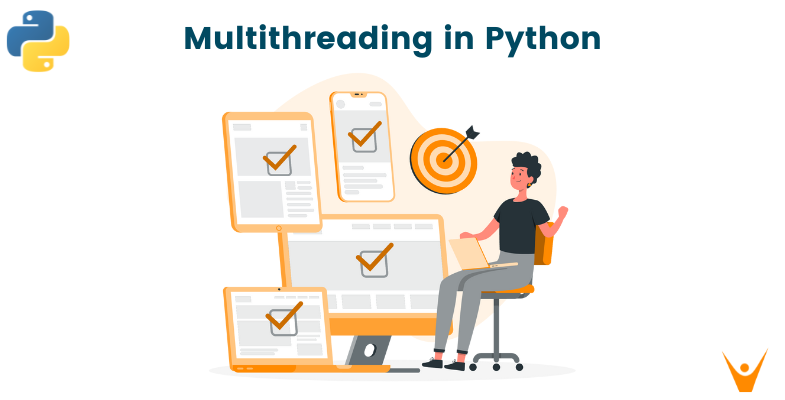Multithreading is a critical concept in computer programming that enables the efficient execution of multiple threads, or small units of a larger process, within a single process. Python, a popular and versatile programming language, also supports multithreading. In this article, we will delve into what multithreading is in Python, provide examples, explain how to implement multithreading, discuss its limitations, and offer insights into when to use multithreading in Python.
What is Multithreading in Python?
Multithreading in Python refers to the concurrent execution of multiple threads within a single process. A thread is the smallest unit of a process and can run independently. It allows your Python program to perform multiple tasks simultaneously, enhancing the efficiency and responsiveness of your applications.
In Python, multithreading is a way to utilize the full potential of modern multi-core processors. When a Python program is threaded, it can run multiple threads, each performing a specific task concurrently. This is particularly useful for I/O-bound operations, such as reading and writing to files or making network requests.
Python Multithreading Example
To better understand how multithreading works in Python, let's consider a simple example. Suppose you want to download multiple web pages concurrently. Traditionally, without multithreading, you would fetch each page sequentially, leading to slower performance. However, with multithreading, you can fetch multiple pages simultaneously, significantly improving the download speed.
Here's a basic Python multithreading example for this scenario:
import threading import requests # Define a function to download a webpage def download_page(url): response = requests.get(url) print(f"Downloaded {url}") # List of URLs to download urls = ["https://favtutor.com", "https://google.com", "https://openai.com"] # Create threads for each URL threads = [] for url in urls: thread = threading.Thread(target=download_page, args=(url,)) threads.append(thread) thread.start() # Wait for all threads to complete for thread in threads: thread.join() print("All downloads are complete.")
In this example, we use Python's threading module to create separate threads, each responsible for downloading a webpage. This allows us to download multiple web pages concurrently.
How to Do Multithreading in Python
To implement multithreading in Python, you need to follow these steps:
1. Import the threading module: The threading module provides the necessary functions and classes to work with threads.
2. Define a function for each thread: Create a function that represents the task you want to perform concurrently.
3. Create thread objects: Instantiate thread objects and specify the target function and its arguments.
4. Start the threads: Use the start() method on each thread object to begin execution.
Wait for threads to complete: Use the join() method to ensure all threads have finished before proceeding with the main program.
It's essential to be cautious when sharing data between threads to prevent race conditions and data inconsistencies. You can use locks or other synchronization mechanisms provided by the threading module to manage shared resources safely.
Can Python Have Multiple Threads?
Yes, Python can have multiple threads. However, it's crucial to note that Python's Global Interpreter Lock (GIL) can impact the actual concurrency achieved by Python threads. The GIL is a mutex that protects access to Python objects, preventing multiple threads from executing Python code simultaneously.
This means that while Python can create multiple threads, only one thread can execute Python bytecode at a time. Consequently, for CPU-bound tasks that involve extensive computation, Python threads might not provide a significant performance boost due to the GIL's limitations.
Why Multithreading is Not Possible in Python?
Multithreading is possible in Python, but it's essential to understand the limitations imposed by the GIL. The Global Interpreter Lock, as mentioned earlier, restricts the concurrent execution of Python bytecode by multiple threads. This limitation is by design and is a trade-off that Python makes for simplicity and memory management.
However, the GIL is not always a drawback. In cases where your program involves I/O-bound operations or tasks that spend most of their time waiting for external resources, multithreading in Python can be quite effective. For CPU-bound tasks, you may need to explore other concurrency mechanisms such as multiprocessing or using external libraries.
When Should I Use Multithreading in Python?
The decision to use multithreading in Python depends on the nature of your application and its requirements. Here are some scenarios where multithreading is beneficial:
1. I/O-Bound Operations: Multithreading is most effective when your program spends a significant amount of time waiting for I/O operations to complete, such as reading/writing files, making network requests, or interacting with databases. In these cases, multiple threads can help maximize CPU utilization.
2. Responsiveness: Multithreading can enhance the responsiveness of your application, especially in graphical user interfaces (GUIs) or interactive applications. By using threads, your application can continue to respond to user input while performing background tasks.
3. Parallelism in I/O Tasks: If your application can benefit from executing multiple I/O tasks in parallel, multithreading is a suitable choice. This can lead to faster data processing and reduced waiting times.
4. Utilizing Multi-Core Processors: Multithreading can help make better use of multi-core processors, as different threads can run on different CPU cores concurrently.
In contrast, multithreading is less suitable for CPU-bound tasks that involve extensive computation, as the GIL's limitations can hinder performance improvements. In such cases, you might consider using the multiprocessing module for true parallelism.
Conclusion
Multithreading in Python is a valuable tool for improving the efficiency and responsiveness of your applications, particularly when dealing with I/O-bound operations. Understanding when and how to use multithreading in Python can empower you to create more robust and high-performing software.








